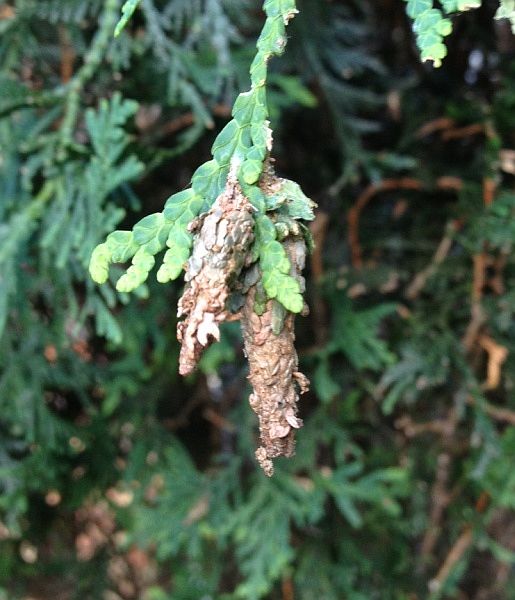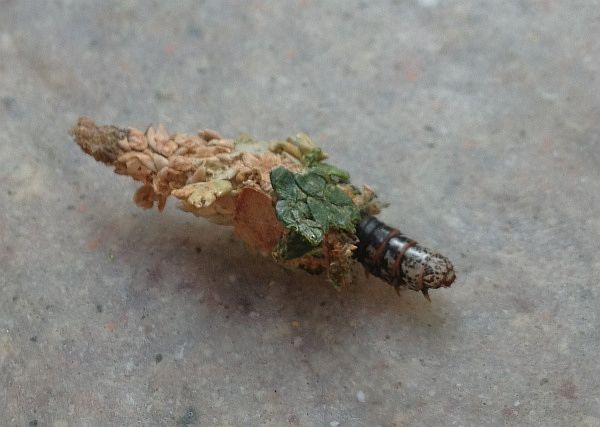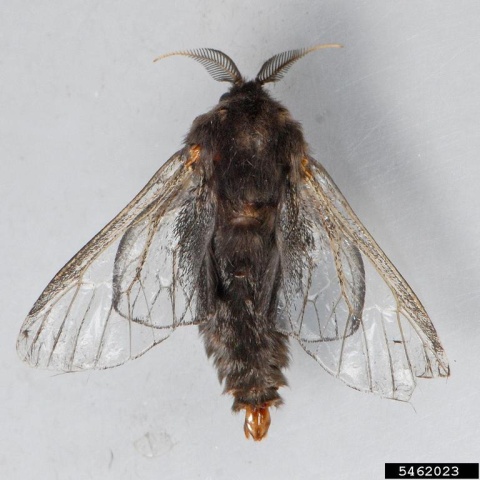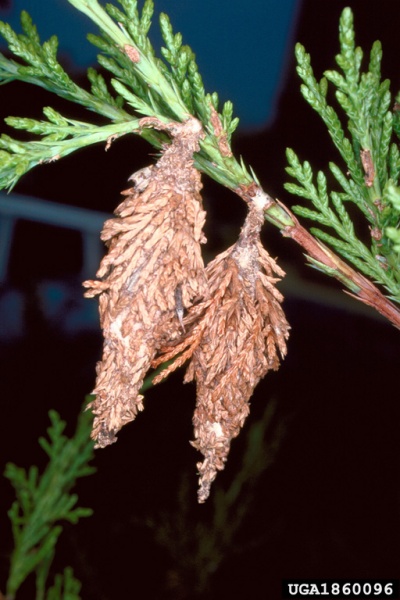
When Steve Tirone learned the identity of these pine cone look-alikes he had his work cut out for him.
Early this month he sent me this photo (below) and asked: “Any idea what this is? I had a few on my house last year. They are near my cedar tree.”

I emailed Monica Miller who replied, bagworm moth caterpillar.
Bagworms adorn themselves with disguising vegetation that eventually becomes their pupating bag. Until then bagworm caterpillars chow down on their favorite foods.
Steve looked closely at his cedar tree and discovered it was covered in caterpillars that were eating it alive. No wonder it looked sick! He also learned that pesticides don’t work on these bag-covered bugs. The only way save his tree was to pull off each one by hand, as in…
[I picked them off] for 2 hours today, along with chopping out large parts of the tree. Ugly work, ugly results, and there are still tons left. Every time I go by the tree I say “How did I miss that one, and that one?” Easy, because they look just like pine cones!
— Steve Tirone, July 2013
If any remain on the tree, what will happen next?
Monica did not specify the bagworm species — there are about 1,350 Psychidae worldwide — but I’ll tell you the story of the evergreen bagworm moth (Thyridopteryx ephemeraeformis (Haworth)) because it’s a particular pest of cedars (Juniperus virginiana) and arborvitae (Thuja occidentalis).
From May to August the caterpillars eat and mature through seven instars. In August the mature caterpillars prepare to pupate by hanging their bags from host plants by a strong silken thread. Then they turn around inside the bag to face downward.
Four weeks later, in September and early October, the males emerge. They’re about an inch long and are easy to overlook because they’re small and black. They eat nothing.

The females never emerge. They’re wingless, legless, have no eyes and no functioning mouth parts. They’re just a bag of eggs and pheromones waiting for a male to land on their bag and mate with them.
As soon as the females have mated they shut off their pheromones, lay 500-1,000 eggs, then die and become mummified inside the bag. The males are long gone, having died within a day or two of their emergence.
Over the winter the bag hangs on the tree with 500 to 1,000 potential caterpillars waiting to hatch from the carcass of their mother.
If you pull these bags off your cedars before they hatch in April you’ll save your trees a lot of trouble.

For more information see this fact sheet from Penn State.
(first two photos by Stephen Tirone. Moth photo (5462023) by Lacy L. Hyche, Auburn University via bugwood.org. Bags photo (UGA1860096) by Mark Dreiling via bugwood.org)
Insidious devils they ! It never ceases to amaze me how Nature seems to fill every conceivable niche in some of the most diabolical ways. What’s a poor Cedar to do?
I didn’t know what they were. I did know they were some kind of insect. But I did not know they were going to kill my tree.
Once you pull them off the tree, is crushing the bags underfoot sufficient? Do you just throw them away? What is the recommended course of action?
Barbara, the literature says to either crush them or drop them into a bucket of soapy water. The literature also says to cut the silken band that holds the bag on the tree. Otherwise it will girdle the branch tip.
Interestingly, bagworms are more of a problem in urban/suburban areas because their natural predators aren’t available.
ugh !!
What are the bag worms natural predators? We found some on blueberry bushes, do they eat those?
Jo
Jo, there are so many moths/butterflies that make odd cocoons that it’s hard to say what kind you have and whether they will eat the the blueberry bushes. If you feel like experimenting, you could pull one off and put it in a jar and wait to see what happens. If you’re worried about the blueberries, ask a local expert to identify the bugs.
Thought for over a year they were pine cones. After seeing the real thing used Ortho Home Defense spray in a gallon container and sprayed them. All I had at the moment. It killed them all!!!!!
Sprayed caterpillars with wasp and hornet spray waited an hour then hosed tree down with water ,it killed all the little nuggets and did not hurt my oak tree, pulled off the pine cone shaped bag worms on my blue spruce tree ,much better now
Found these pests all over my neighbors house.
They also are growing on brick my is house brick they have covered my one-sided wall outside also all around my windows
can these pine cone looing bagworms bite or sting people or animals?,my Italian cedar looks dead,,it is only 16 years old and would really like to keep it what do i do??????
I use a handheld blow torch and start from the bottom of the bag and work up, torching the cocoon and killing the larvae. Be careful on dry days so that you do not start a fire.
Brent, well … “dry day” or not the tree may catch fire because it is dried out (under stress). Pulling the bags off by hand is as fast or faster than the time it takes to very carefully aim a blow torch.
Soon the bagworms will enter their adult reproductive life cycle — a period in which they never eat. The new bagworm larvae don’t emerge until early April so there’s time to pull the bags off by hand.
I found a pile of these (easy 40+) under some metal shelving we brought home one day. I moved the shelving and there they were. I thought they fell off the bottom of the shelving. Left the pile lay to clean up later. Couple of days later the pile was gone, thought my husband cleaned them up. moved a different box on my patio, there was another pile. So i asked my husband if he had cleaned them up and he said “no” he had not. So did these little buggers moved across my patio ???? can they crawl in the cocoon ??
The caterpillars do poke out of their shelters but I don’t believe they crawl. Perhaps you had 2 piles
Yes!!! They do crawl. I cut a dead branch off my arborvitae tree and put it in the trash thinking those were pine cones. Hours later they had moved all over the can. The next day they were up the walls, dangling from the gutters and on the ceiling of my front porch. It was horrible!! They crawl long and far.
They absolutely do crawl! Watched three of them scoot across our driveway yesterday!
Thank you so much you just saved my emerald green arboviates.
There are 100’s of them hanging from evergreen bushes in from of my home in Myrtle Beaach SC. Yes they do crawl inside the cone!! They have destroyed several bushes completely.. I didnt know what they were at first thought it was something the bush grew! Have been pulling them off for weeks but there are so many! Now know to drop them in soapy water..i have been stomping on them..they are almost impossible to destrpy!
Saw a few of these “glued” to the precast panels on the Ford dealership here in Lafayette. One was on the ground under a cedar tree crawling along?
Hi! I enjoy your site very much! I have a question about someRed Spider Lily bulbs that I dug up. They were my Grandma’s and are over 100 yrs. old. I would like to know how I can store some of the bulbs, to share with Family members who have ask for some of them, & they live a few hundred miles away.
Also would like to know how long I can store them, & do they need to be planted in the Fall or the Spring? I live in planting zone 7 & they are in zone 8. Thanks for any advice you can give me!
Elaine Brooks, I’m sorry I can’t answer your question. I’m not a gardener and I didn’t even know red spider lilies existed until you asked your question. Sorry I can’t help on this one.
Ahh, Bagworm Moths. There has been 3 at our office here in Connecticut on our windows!! Whatever these guys use to glue themselves is STRONG and was not easy to tear them down. I wanted it to be left alone, but my co-worker insisted and volunteered to take it town herself. What’s left is this dark long (2 inch) larvae of goo and slime…. it looks worse! So if these guys are on your windows, be careful, it could become a bigger mess! Probably just leave them if its just a few. Yikes to those who have a multitude harvesting in their yard.
I never saw these ‘cones’ on my evergreens before but did see one of my perennial praying mantis in the same row of yews. Could it have been eating the moths? This is the first time I noticed the infestation and pulled off as many as I could find now being the third week in May. Should I notify the extension of my find here on Long Island?
R. Dabola, since the praying mantis is a top predator in the bug world I’ll bet it was eating those moths. You’re fortunate to have help with them. … The local Extension Service might be interested in what you’ve found in your yard.
Thanks for the article. I found one on the side of my house and didn’t know what it was.
I have these all over my evergreen trees now and they’re hatching. There are too many to pull off by hand what can I do?
Greg Moyler, I don’t know any answer other than pulling/cutting them off by hand. Because these critters are in “bags,” pesticides don’t work on them (except in a brief window of time in early to mid June. It’s too late for that now.)
Ugh! These are covering the only tree in my front yard. I learned what they are today on this site. Thanks for the info!
Just grab the flame thrower
Welllll… Now I know what these things are, been wondering why these “small pine cones” been dropping out of the tree like a spider coming down from a tree branch. I thought that was strange. But once I saw the dang thing crawling across the sidewalk and noticed a little black caterpillar sticking out of it, I looked up in the tree annnd “Oooooh boy, there’s 1,000s of them!” My question, will they eat the vegetation or veggies in the garden? I don’t want to go around killing something that’s gonna do no harm, ya know what I mean?
Brad Thomas, they will eat your tree!
Oh no I have literally dozens of these on my pine trees how can I save them a my trees I love my bugs and my trees please help!
Nicole, unfortunately you’ll have to pull them off one at a time. Tedious but necessary.
Just had to take down a huge perfect Christmas tree because of these! They destroyed it in less that a year! So sad……….
I found one of these on my back deck attached to a metal polls with a spider web next to it. I thought it was a cocoon for spider eggs.
HELP! this worms are destroying my trees. Can someone please help me identify them? I don’t know where to post a picture.
I live in a very rural area and planted a slow growing creeping cedar which after 5 years or so is about 6′ tall. Every year I have to pull these buggers off, but my huge natural to the area cedar doesn’t get them. I don’t know what I will do when the tree gets too tall to reach all of them, but they are horrible. The first year I was thinking it was a pod that was already hatched, oh no….put about 200 in a bucket, later found many gone and the rest crawling up the side of the bucket. I burn them asap now.